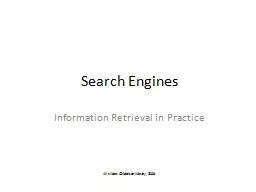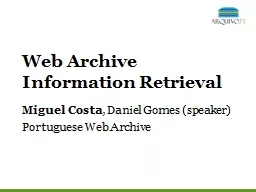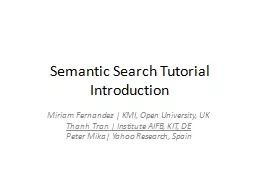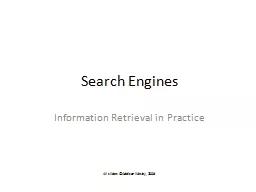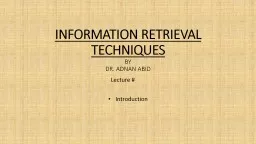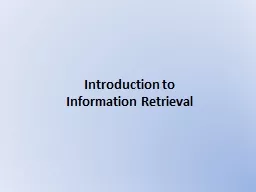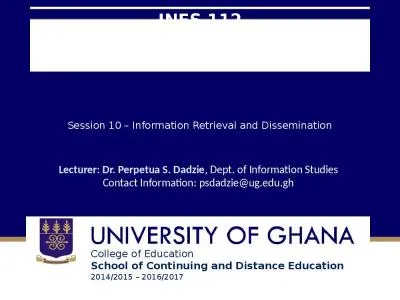PPT-Information Retrieval and Web Search
Author : cheryl-pisano | Published Date : 2019-06-23
Boolean retrieval Instructor Rada Mihalcea Note some of the slides in this set have been adapted from a course taught by Prof Chris Manning at S tanford University
Presentation Embed Code
Download Presentation
Download Presentation The PPT/PDF document "Information Retrieval and Web Search" is the property of its rightful owner. Permission is granted to download and print the materials on this website for personal, non-commercial use only, and to display it on your personal computer provided you do not modify the materials and that you retain all copyright notices contained in the materials. By downloading content from our website, you accept the terms of this agreement.
Information Retrieval and Web Search: Transcript
Boolean retrieval Instructor Rada Mihalcea Note some of the slides in this set have been adapted from a course taught by Prof Chris Manning at S tanford University Typical IR task. Miguel Costa. , Daniel Gomes (speaker). Portuguese Web . Archive. Information Retrieval. is the activity of obtaining . information resources relevant. . to an . information need. from a . collection. Information Retrieval in Practice. All slides ©Addison Wesley, 2008. Search and Information Retrieval. Search on the Web. 1. is a daily activity for many people throughout the world. S. earch and communication are most popular uses of the computer. Miguel Costa. , Daniel Gomes (speaker). Portuguese Web . Archive. Information Retrieval. is the activity of obtaining . information resources relevant. . to an . information need. from a . collection. Tutorial. Introduction. Miriam Fernandez | KMI, Open University, UK. Thanh Tran | Institute AIFB, KIT, DE. Peter Mika| Yahoo Research, Spain. Search . Document Retrieval vs. Data Retrieval. Differences of search technologies. ChengXiang. (“Cheng”) . . Zhai. Department of Computer Science. University of Illinois at Urbana-Champaign. http://www.cs.uiuc.edu/homes/czhai. . Email: czhai@illinois.edu. 1. Yahoo!-DAIS Seminar, UIUC. Hongning. Wang. CS@UVa. Classical search engine architecture. “The . Anatomy of a Large-Scale . Hypertextual. Web Search . Engine”. - Sergey . Brin. and . Lawrence Page, . Computer networks and ISDN systems. Hongning. Wang. CS@UVa. Classical search engine architecture. “The . Anatomy of a Large-Scale . Hypertextual. Web Search . Engine”. - Sergey . Brin. and . Lawrence Page, . Computer networks and ISDN systems. Hongning. Wang. CS@UVa. Recap: Core IR concepts. Information need. “. an individual or group's desire to locate and obtain information to satisfy a conscious or unconscious need. ” – wiki. An IR system is to satisfy users’ information need. All slides ©Addison Wesley, 2008. Beyond Bag of Words. “Bag of Words”. a document is considered to be an unordered collection of words with no relationships. Extending representation. feature-based models. BY. DR. ADNAN ABID. Lecture # . Introduction. Library Management System. Structured Data Storage / Tables. Semi-Structured and Unstructured . Employee Department Salary. Library Digitization. Information Retrieval Models. Hongning. Wang. CS@UVa. CS@UVa. CS6501: Information Retrieval. 1. Abstraction of search engine architecture. User. Ranker. Indexer. Doc Analyzer. Index. results. Crawler. Doc . Representation . Query Rep. What is IR?. Sit down before fact as a little child, . be prepared to give up every conceived notion, . follow humbly wherever and whatever abysses nature leads, . or you will learn nothing. . . -- Thomas Huxley --. PRESENTED BY . Peter Mika, Sr. Research Scientist, Yahoo Labs. . ⎪ . November 27, . 2014 . The Semantic Web (2001-). 11/27/14. 2. Part of Tim . Berners-Lee’s . original proposal . for the . Web. Session 10 – Information Retrieval and Dissemination. Lecturer: Dr. . Perpetua. S. . Dadzie. , Dept. of Information Studies. Contact Information: psdadzie@ug.edu.gh. Session Overview . At the end of the session, the student will be able to.
Download Document
Here is the link to download the presentation.
"Information Retrieval and Web Search"The content belongs to its owner. You may download and print it for personal use, without modification, and keep all copyright notices. By downloading, you agree to these terms.
Related Documents


